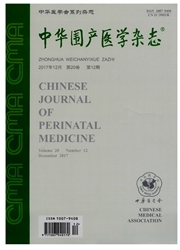

 中文摘要:
中文摘要:
目的探讨中间型单核细胞在子痫前期发病过程中的作用。方法选择2014年10月至2015年10月在江苏省盐城市滨海县人民医院诊断为子痫前期的孕妇52例,同期健康孕妇42例和健康未孕女性42例作为对照组。采用流式细胞技术检测外周血中间型单核细胞比例,及其细胞表面Toll样受体(Toll-like receptor,TLR)2、TLR4、CD64和髓系细胞触发受体-1(triggering receptor expressed on myeloid cell-1,TREM-1)的表达(以阳性细胞比例和平均荧光强度表示),以及中间型单核细胞内肿瘤坏死因子-α(tumor necrosis factor—α,TNF—α)和白细胞介素(interleukin,IL)-6含量(以平均荧光强度表示)。液相芯片技术检测各组血清IL-6、IL-1β、TNF—α、IL-8和IL-12P70浓度。采用两独立样本t检验、单因素方差分析、Mann—Whitney U检验、Kruskal Wallis检验和Pearson相关分析进行统计学处理。结果子痫前期组中间型单核细胞比例为10.4%(5.3%~19.9%),高于健康孕妇组[6.6%(4.9%~7.8%)1,2组均高于健康未孕组[3.8%(2.4%~5.0%)](P值均〈0.01)。子痫前期组TLR4[(60.1±12.5)%与(24.9±8.8)%]和CD64阳性中间型单核细胞比例[(85.3±5.4)%与(67.4±7.5)%]均高于健康孕妇组,中间型单核细胞表面TLR4(50.3±10.2与26.8±8.6)、TREM-1(35.6±4.1与28.6±4.7)和CD64的平均荧光强度(39.8±5.2与28.9±4.8)也高于健康孕妇组(t值分别为15.416、13.437、11.898、7.707和10.454,P值均〈0.01)。子痫前期组中间型单核细胞内IL-6和TNF—α的平均荧光强度分别为32.3±4.7和44.6±6.3,均高于健康孕妇组(分别为28.6±3.5和36.7±8.3)(t值分别为4.239和5.245,P值均〈0.01)。子痫前期组血清IL-6、IL8和TNF—α浓度高于健康孕妇组和健康未孕组,差异均有统计学意义(P
 英文摘要:
英文摘要:
Objective To explore the role of peripheral blood intermediate monocytes in the pathogenesis ofpreeclampsia. Methods Fifty-two patients with established preeclampsia in Binhai County People's Hospital from October 2014 to October 2015, 42 healthy pregnant women and 42 healthy non-pregnant women were enrolled in this study. The percentage of intermediate monocyte subsets, ratio of positive cells and mean fluorescence intensity (MFI) of Toll-like receptor (TLR) 2, TLR4, CD64, and triggering receptor expressed on myeloid cell-1(TREM-1), and MFI of intracellular tumor necrosis factor- α (TNF-α ) and interleukin (IL)-6 were evaluated by flow cytometry. The concentrations of IL-6, IL-8, IL-1β, IL-12P70 and TNF-α in serum were analyzed using Luminex liquid phase chip technology. Independent two samples Hest, analysis of variance, Mann-Whitney U test, Kruskal-Wallis test and Pearson correlation analysis were used for statistical analysis. Results Percentage of intermediate monocytes was higher in preeclampsia patients [10.4%(5.3± 19.9%)] than in healthy pregnant women [6.6%(4.9±7.8%)], and both were higher than in non-pregnant women [3.8%(2.4±5.0)%] (all P〈0.05). The ratio of TLR4 and CD64 positive intermediate monocytes [(60.1 ± 12.5)% vs (24.9 ± 8.8)%; (85.3 ± 5.4)% vs (67.4 ±7.5)%] (t were 15.416 and 13.437, both P〈0.05), and MFI of TLR4 (50.3± 10.2 vs 26.8± 8.6), TREM-1(35.6±4.1 vs 28.6±4.7) and CD64 (39.8±5.2 vs 28.9±4.8) (t were 11.898, 7.707 and 10.454, all P〈0.05) were higher in preeclampsia patients than in healthy pregnant women. MFI of intracellular IL-6 (32.3 ± 4.7 vs 28.6± 3.5) and TNF- α (44.6 ± 6.3 vs 36.7 ± 8.3) in intermediate monocytes of preeclampsia patients was also significantly higher than that of healthy pregnant women (t were 4.239 and 5.245, both P〈0.05). Serum concentrations of IL-6, IL-8 and TNF- α were higher in preeclamptic patients than in healthy pregnant women and non-pregn
 同期刊论文项目
同期刊论文项目
 同项目期刊论文
同项目期刊论文
 期刊信息
期刊信息
